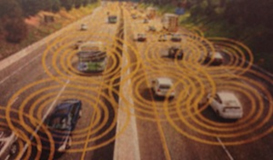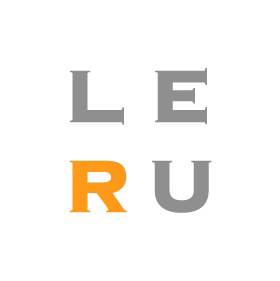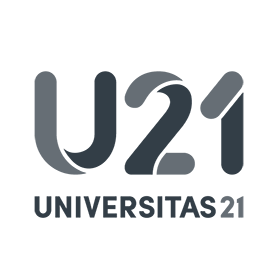News archive, 2013
Microposter: Wireless Communication in Automotive Environment (WCAE)
Published: 2013-12-11
| ||||||||||||||||||||||||||||||||||||||

Wireless Communication in Automotive Environment (WCAE)
Cars peeking around the corner!
No traffic accidents!
Garage recession!
Fredrik Tufvesson and his colleagues help people, environment and road traffic to co-exist better and more safely. A specially adapted vehicle wifi standard (IEEE 802.11p) is one of the bricks they use in order to let cars and road infrastructure talk to each other. Their system helps drivers avoid quick and difficult decisions in order to eliminate fatal mistakes behind the wheel.
In addition to provide robust wifi-based communication, the team must also handle strict control of the entire system and how things behave. Challenges include management of electronics, antennas, high frequency environment, wave propagation, dynamics, system simulation, etc. And also to handle two somewhat contradicting worlds that meet, cars with long lifecycles and electronics with tight, is a tough task. The research commercial "roll-out" is 2016 and Volvo is of course participating. We are in Sweden, right?
Check out the "microposter" (to the right) which will give you a good overview. Contact Anders Borgström if you'd like to 'micropost' your project
Text: Anders Borgström | Photo: Johan Cedervall
Frida Sandberg on Air
Published: 2013-12-09
Frida Sandberg participated in Sveriges Radio (Swedish public service radio) on Sunday. You can listen to the show by clicking here (Frida enters the studio at approximately 2 hours and 37 minutes). It's in Swedish.
- We talked about how electrical potentials, measured on the surface of the skin, reflects what's happening inside the body. I also spoke about my research on analysis of ECG signals during atrial fibrillation.
”Attitude is as important as knowledge”
Published: 2013-12-02
Environmental Coordinator Maria Nilsson visited EIT on the occasion of the upcoming environmental audit in December. She informed about the University's important role (also) on the sustainable development and opened up a discussion about how we can take our responsibility for sustainable development, to "Practice what we preach".
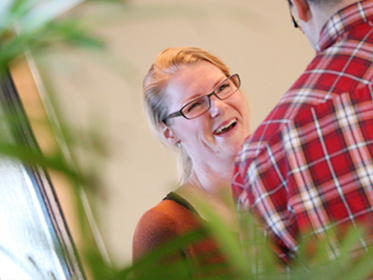 Maria Nilsson. Foto: Johan Cedervall
|
An important role
Lund University has an important role in society and shall be a driving force for sustainable development. As an educational authority, the university has a key role in providing reliable knowledge and integrating sustainable development permeate the core business. One example is that in an increasingly raising awareness of sustainability in all research. Another example might be to give students a good understanding of how those future society formers can influence the world by integrating sustainability in their future work.
The individual contribution makes a difference
Yes, the ambitions are big but the roads may seem vague and your own contribution can feel negligible. Maria Nilsson informed about LU's overall policy (above) and opened up for discussion at the EIT info meeting on Thursday November 28th.
– The attitude is as important as knowledge, pointing out any and received support from another group that pointed to right the perceived betydelselösheten around the individual's contribution.
– It is a very common perception, but the individual operation do a difference! Maria pointed out.
Environmental work at the EIT
EIT has a policy that very concretely describes different ways in everyday department take an active position of sustainable development. It can be found here. It does not include work to actively think about sustainable development in everyday research. It is something that more or less everyone already does, but maybe do not focus on as much as you might.
– In principle, all the research we are doing here is about reducing energy consumption in one way or another, but often it milliwatt or microwatt. Though, it is clear that extensive use does the difference, reflected one scientist.
Read more:
- EIT internal: Environmental work (Swedish)
- Miljöarbete vid EIT (pdf, in Swedish)
- Environmental work at Lund University (Swedsih)
- Maria's presentation
Text & foto: Johan Cedervall
Best Paper Award
Published: 2013-11-28
Best paper award: T. Abbas, A. Thiel, T. Zemen, C. F. Mecklenbräuker and F. Tufvesson, “Validation of a Non-Line-of-Sight Path-Loss Model for V2V Communications at Street Intersections” at the 13th International Conference on ITS Telecommunications, Tampere, Finland.
Sådana är di, pensionärerna
Published: 2013-11-28
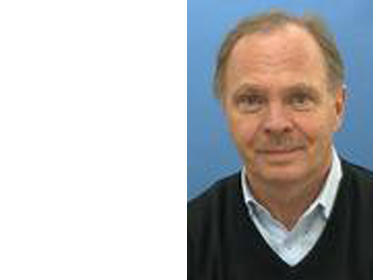
Ulf Körner
Ulfs forskningsområde är kommunikation, speciellt datakommunikation och radionät. Ingenting kunde vara lämpligare - få har lättare att få kontakt med människor än Ulf. Om han kommer till ett helt nytt ställe så dröjer det inte många minuter innan han är i glatt samspråk med någon. Ulf är expert på köteori, vilket är märkligt eftersom han avskyr att stå i kö. Men köteori är viktigt när man forskar inom Ulfs områden. Att höra Ulf föreläsa om om köteori och hur den används är en upplevelse, lite som ett väckelsemöte.
Förutom forskning och undervisning har Ulf också gjort en stor insats som styrelseledamot i Post och Telestyrelsen och börsnoterade företag. Han har också varit rådgivare åt flera företagsledningar. Låt oss gissa att de inte bara har fått expertråd utan också en och annan god historia av Ulf.
När Ulf inte arbetar så sjunger han i kör, spelar gitarr, bygger växthus
och ibland glider han fram i en segelbåt på tropiska vatten.
Han abonnerar också på en medaljplats i institutionens årliga golfturnering.
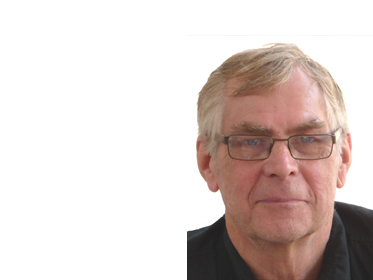
Bengt Mandersson
Bengt Mandersson började sin akademiska bana på institutionen för teletransmissionsteori med att forska på matematiska metoder för att tolka medicinska signaler. Med undantag för några år som forskare på institutionen för lingvistik har Bengt varit E-huset trogen och framförallt varit ett ankare i undervisningen av signalbehandling. Många tusen är de studenter som examinerats av Bengt i signalbehandling, och många är de studenter som uttryckt stor uppskattning för hans stora engagemang i undervisning genom att alltid ge generöst av sin tid!
Bengt har även ett stort internationellt intresse och var under många år engagerad i ett SIDA-finaniserat forskningprojekt tillsammans med Nicaragua där han handledde flera doktorander. Detta intresse avspeglas också i att han tagit ett omfattande ansvar vad gäller Kina-inriktningen på LTH och undervisade ett flertal år i Hangzhou.
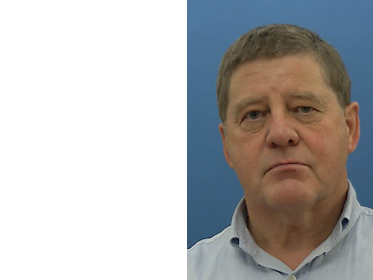
Clas Agnvall
Clas är en jovialisk smålänning som bytte skogarna mot den Skånska slätten och det Lund som Esaias Tegnér kallade den akademiska bondbyn. Efter att ha disputerat på transistormodeller inom fysik och en kort tur i näringslivet kom Clas till vad som då var Institutionen för Tillämpad Elektronik i senare hälften av 80-talet. Han undervisade många studenter inom grundläggande elektronik, speciellt analog sådan och var med om att introducera Nullorn vid LTH. Senare blev han Prefekt och översåg den lyckade sammanslagning och integreringen av ”Tillämpad” med ”Teorel”, vilket skapade Elektrovetenskap. Under sin senare gärning hjälpte han LTH med ett antal centrala uppdrag.
En stor del av undervisningen handlade om återkoppling och som ett forskningsprojekt har Clas intresserat sig för återkopplade högtalare. Han är också en inte oäven snickare, båtbyggare (om än sjövärdigheten kan ifrågasättas), krukmakare och bambuodlare.
Microposter: Wireless Communication for Ultra Portable Devices (UPD)
Published: 2013-11-19
| ||||||||||||||||||||||||||||
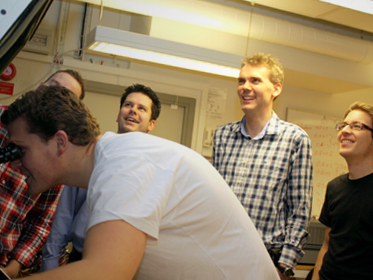
Wireless Communication for Ultra Portable Devices
Hearing aids that are talking to each other!
The body connects to the net!
Internet feelers!
Henrik Sjöland and his colleagues makes this all possible through their efforts in the SSF-funded project UPD, Ultra Portable Devices.
With extremely low power and miniaturized solutions that can be used to extend battery life in critical technology products, building blocks and systems will gradually take place. Examples of future product applications are hearing aids that communicate with each other, pacemakers and other body implants, small sensors or other devices with extreme demands on space and energy efficiency. The team now has a complete system design in place and continuously performs tests on silicon-based building blocks.
Also, check out the project's so-called "microposter" (to the right) which provides quick overview and sense of the whole. From now on you'll see more of the department's projects in this format and the research coordinator Anders Borgström responsible for the launch. Contact Anders if you want to show your project!
Text: Anders Borgström | Photo: Johan Cedervall
EIT-researchers gets SEK 11 Million from VR
Published: 2013-11-11
Michael Lentmaier gets SEK 3.880k for project Spatially Coupled Turbo-Like Codes, Lars-Erik Wernersson gets SEK 3.452k for project III-V p-type MOSFETs at Scaled Gate Lengths and Viktor Öwall gets SEK 3.452k for the project Implementation of Faster-than-Nyquist Signaling - From Theory to Silicon.
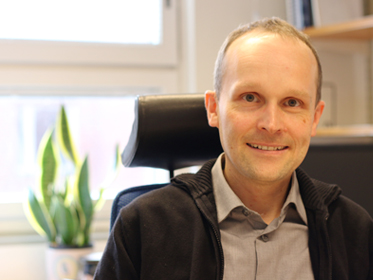 Michael Lentmaier gets SEK 3.880k. Photo: Johan Cedervall |
New but known addition
Michael Lentmaier is one of the newer contributions to EIT, he entered the service of the EIT in January - but actually he is rather a returnee because it was at LTH and in the current EIT included Department of Information Technology as Lentmaier achieved his doctorate in 2003.
– After I defended here I was in the U.S. as a postdoc for a year. Then I felt that I’d been away a long time and returned home to Germany where I was until this year when I entered the service here at EIT, Michael tells me. He thrives in Sweden and
prefer the Swedish university system.
– In Germany, a professor has usually got an entire department to operate, which makes the professor more of a manager with lots of Ph D students working for him. It is also very hierarchical, which I do not think it is here and I prefer things they are here.
Graphs are popular
Coding is a very theoretical area but simultaneously occurring everywhere where there is digital communication. And these places are becoming more in line with systems and equipment communicate with each other at an ever greater extent.
– In my project 'Spatially Coupled Turbo -Like Codes’, very powerful codes ought to be constructed by using several simple component codes together in a composite system.
– The codes interconnection can be described with the help of graphs, which has become very popular in the coding research area because very long codes can be constructed without dramatically increasing the complexity of decoding.
Cooperation with Chalmers
The project is run in conjunction with Alexandre Graell i Amat at Chalmers in Gothenburg.
– I am confident that our cooperation will bring a good result, says Michael and tells that the majority of the pie goes to the funding of a PhD student at EIT.
– I also want to emphasize that I think it's important to get the VR money for this kind of research, as you say, is rather theoretical basic research. I think it is very appropriate!
– We expect that the results will provide new insights for the design of practical systems, says Michael Lentmaier in conclusion.
Read more: Vetenskapsrådet (in Swedish).
Text & photo: Johan Cedervall
"UPD Radio" vinnare av Venture Cup Syds pitchmoment
Published: 2013-10-31
Text: Venture Cup
Bland 156 tävlingsbidrag i Sveriges enda nationella vidoepitchtävling är nu 4 regionala vinnaren korade.
I Syd har konkurrensen har varit stenhård och juryns 20 medlemmar har haft den delikata uppgiften att utse bästa pitch i Venture Cup Syd hösten 2013.
Men hur gick det till?
Varje tävlingsdeltagare/team fick i uppdrag att pitcha sin affärsidé under max 60 sekunder. Ingen efterredigering eller specialeffekter var tillåtna. En "ren" pitch helt enkelt.
Hur utsågs vinnaren?
Tävlingsbidragen betygsattes utifrån två parametrar vilka viktades lika: "Idé" respektive "Framförande". Högst medelbetyg = vinnande bidrag
Vinsten?
Bästa pitch i region Syd vinner konsulttjänster från den digitala resultatbyrån Resultify till ett värde om 10.000 SEK. Resultify erbjuder en heldags workshop med en affärsutvecklare och en marknadsförare där du vässas i hur du kan använda de digitala kanalerna för ditt erbjudande.
Och vinnande bidrag är... .
UPD Radio
Lagledare: Reza Meraji
Teammedlemmar: Yasser Sherazi, Carl Bryant & Rohit Chandra
Institutionen för Elektro- och informationsteknik, Lunds Tekniska Högskola
"The UPD Radio provides an ultra-low power and highly efficient miniature radio chip for short range wireless devices, such as hearing aids. The estimated power consumption is 5-6 times lower than that of our competitors. This will allow a customer to provide products with an extended battery life, and improved wireless connectivity without additional costs."
http://venturecup.se/tavling/vinnare/
EIT-initierad utställning på Livets museum 1 november
Published: 2013-10-31
Fredagen den 1 november klockan 14:00 inviger rektor Per Eriksson utställningen ”Höra och Lyssna – teknik i hörselns tjänst” på Livets museum (på "Valvet"). Banbrytande forskning inom området och en ny uppfinning av EIT-forskaren Nedelko Grbic har initierat utställningen.
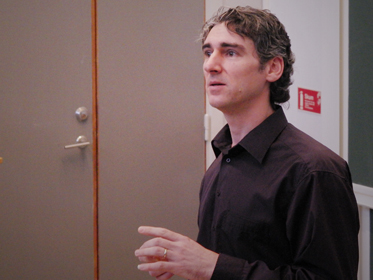 Nedelko Grbic får människor att lyssna. Foto: Johan Cedervall |
Stora delar av texten är hämtade från arrangörens pressutskick, i vissa fall omskrivna.
Med hjälp av en akustisk lösning i form av ett millimeterstort chip, som kan placeras i hörapparat, hörhjälpmedel samt hörselskydd, kan allt ljud utom mänskligt tal filtreras bort.
– Det skyddar hörseln, stoppar oönskat ljud och förstärker önskat ljud, berättar Lars Malm som är huvudansvarig för utställningen och professor emeritus i öron-, näs-, halssjukdomar. I en förövrigt bullrig miljö släcker chipet det ljud som är skadligt och obekvämt men släpper samtidigt igenom önskat ljud som mänskligt tal eller larmsignaler.
Hur detta går till kommer Nedelko Grbic att föreläsa om under invigningen.
– Projektet är ett bra exempel där signalbehandling och kretsteori möts, avslöjar "Nedo" såhär dagen innan invigningen.
– Uppfinningen kan med fördel också utnyttjas som hörselhjälpmedel i förstärkare vid föreläsningar och konferenser. Ett bra exempel är en utrustning som museet just köpt in som heter Comfort Digisystem, säger Lars Malm.
Livets Museum, Valvet i Lund. Fredag den 1 november kl. 14.
2013-10-18 Han är Årets Gigant
Published: 2013-10-18
Länge har det snackats om vad som av många beskrivs som årets viktigaste händelse. Den kallas "Giganternas kamp". Den är EIT:s årliga golftävling.
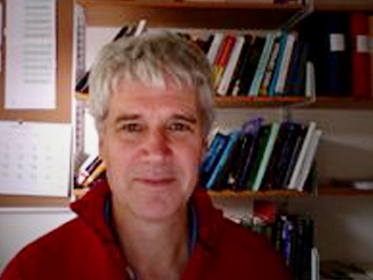 Årets Gigant. Foto: Privat |
EIT-mästerskapen i golf hölls i år den 2/10 på Lunds Akademiska Golf Klubb. Det var typ 85:e gången som tävlingen avgjordes och majoriteten av deltagarna minns, med värme, majoriteten av tävlingarna.
Tävlingen uppges ha hållit "en mycket hög klass", ett direkt citat av en av de fåtalet närvarande deltagarna.
Vann gjorde Anders Karlsson vilket gör honom till Årets Gigant.
Det omfattande eftersnacket handlade för omväxlings skull inte om huruvida golf är en sport eller ej, inte heller om alla miljoner som rimligen eller orimligen tillfallit den lycklige vinnaren. Nej, eftersnacket handlade framförallt om Richard Lundins enastående insatser som caddie - en prestation som belönades med ett hedersomnämnande i den prestigefyllda tävlingen.
Bengt Mandersson knep andraplatsen före Ulf Körner som fick nöja sig med ett brons.
– Jag är stolt, kommenterar Ulf plikttroget avslutningsvis.
Sammanfattning: Johan Cedervall
2013-10-03 Professor emeritus James L. Massey, Tech. Dr., honoris causa, from Lund University, passed away on June 16, 2013
Published: 2013-10-03
James Lee Massey died on June 16, 2013 at his home in Copenhagen, Denmark. Jim was an extraordinary scholar, a gifted teacher, a generous mentor, a true gentleman, and a dear friend.
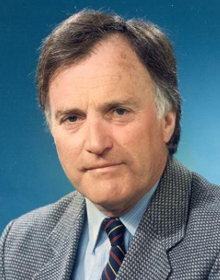 James L. Massey. Photo: IEEE GHN |
Text: IEEE Information Theory Society.
Jim Massey was born in Wauseon, Ohio, on February 11, 1934. He received the BSEE degree (maxima cum laude and class valedictorian) from the University of Notre Dame in 1956, the MSEE and Ph.D. degrees from MIT in 1960 and 1962, respectively, the Dr. Tech. degree, honoris causa, from Lund University, Sweden, in 1990, and an honorary doctoral degree from the Technical University of Munich, Germany, in 2006. [In 1998 he was the first to be awarded the degree of Professor, honoris causa, from the Russian Academy of Sciences, Russia.] He joined the faculty at the University of Notre Dame in 1962 where he remained until 1977. He was the first endowed professor of the University of Notre Dame. He was with UCLA from 1977-1980 and joined ETH Zurich, Switzerland, in 1980. He retired from ETH in 1998 and moved to Copenhagen where he continued his career of scholarship and mentoring.
Jim received numerous awards, including the Shannon Award in 1988, the IEEE Alexander Graham Bell Medal in 1992, the Marconi Prize in 1999, and the Information Theory Society Distinguished Service Award in 2004. He was elected to the U.S. National Academy of Engineering, the Swiss Academy of Engineering Sciences, the European Academy of Sciences and Arts, and the Royal Swedish Academy of Sciences. His scientific work focused on coding theory and cryptography. His work on coding theory included developing links between convolutional codes and linear systems, and the development of the Berlekamp-Massey algorithm for decoding BCH codes. His work on cryptography included the invention of the block ciphers IDEA and SAFER+ which have found wide-spread use and have inspired other block cipher designs.
Oliver reading. [Rolf: Doesn´t Oliver look a bit stuffed? He must be reading John´s chapter! Jim: No. He was reading one of your chapters when I interrupted him to take the picture. He is asking me what I want. He then went on to say about what he had read, that "It's not bad."] Photo: James L. Massey |
In memory of a gentle genius
Professor Rolf Johannesson, about a man who changed his life and became a life-long friend of his ― and the special relationships that evolved to Jim Massey’s dogs.
A slightly edited version of Rolf Johannesson’s talk at the James Lee Massey Memorial Event at the International Symposium on Information Theory, July 8, 2013, Istanbul, Turkey:
I became a Ph. D. student in 1970 at the Department of Teletransmission Theory, LTH. Most of my time during the first year was devoted to teaching Linear Systems. The rest of my time was spent on convolutional coding, which I had become interested in when I took Göran Einarsson´s undergraduate course in Information Theory. During the second year a miracle occurred that totally changed my life. Jim Massey was spending his sabbatical at DTH (now DTU) in Lyngby, north of Copenhagen. In the early 1960s Göran and Jim had shared an office at MIT. Once a week Göran, Carl-Erik Sundberg and I would take the hydrofoil across Öresund to enjoy Jim´s most inspiring lectures. Jim gave me advice that I found to be most helpful. He suggested that I should have a look at Dan Costello´s Ph. D. thesis, which was rushed to me by Jim´s secretary at Notre Dame. Reading it very carefully provided me with a head-start for my own work. During 1973-74 I spent 14 months as Jim´s student and essentially finished my thesis during that time. It was a period that marked the beginning of a close and deep friendship that lasted until he passed away. It is an honor to have been Jim´s friend. For me he can readily be described as a gentle genius.
Jim would not forgive me if I did not include a few words about his dogs. During their time in Europe, Jim and Lis had three dogs: Flusy, Oliver and Oskar. Jim loved his dogs as much as he loved information theory. Oliver is best known to the Information Theory Society. Jim brought him to many sessions at symposia and workshops. Oliver quickly became the world- leading canine information theorist. I benefitted a lot from debating various issues with Oliver, mostly via e-mails. Oliver showed me no respect; Jim was very pleased when he could report ―with a gentle smile―that Oliver had peed in one of my shoes! On 080808 my grandson Oliver Bissett was born. In September 2010 I got an e-mail from Jim that Lis and he got a successor to Oliver which they named Oskar (with a k). My response was that the following January our grandson Oliver would get a brother whose tentative name, at least since August, had been Oskar (with a k). Jim was sure that I was kidding, but this time I was not.
The last time I visited Jim was 2½ weeks before he passed away. He joked and smiled as usual and was in a good mood, though physically he was very weak.
I had brought a bottle of fine Scotch single malt that we sampled.
It was our last whisky together…
In appreciation,
Rolf Johannesson
Professor in Information Theory
An IEEE web link with information on Jim's life and career: http://www.ieeeghn.org/wiki/index.php/James_L._Massey
An IEEE interview with Jim: http://www.ieeeghn.org/wiki/index.php/Oral-History:James_L._Massey
An information theory blog: http://blogs.princeton.edu/blogit/2013/06/16/james-l-massey-1934-2013/
2013-09-20 Rabaey at Innovation in Mind presentation
Published: 2013-09-20
On the conference Innovation in Mind, September 18-19, “our” Honorary Doctor Professor Jan Rabaey, UC Berkeley, gave an invited presentation titled The innovation is in the Mind – neuroscience, nanotechnology and information technology on a convergence path. You can download Jan's presentation here.
Innovation in Mind site: http://www.innovationinmind.se/.
2013-06-11 On The Cover!
Published: 2013-09-13
Wireless communication is a runaway success with the public, but the number of bits that our systems need to carry is growing faster than traditional transmission methods can sustain. How can we carry more bits through a given space and radio spectrum? A number of ways are being explored at EIT, and one that was pioneered here is called faster than Nyquist (FTN) transmission. Three EIT researchers, John B Anderson, Fredrik Rusek and Viktor Öwall, have authored the paper “Faster than Nyquist Signaling”, a survey of FTN methods which was the cover article in the August 2013 Proceedings of the IEEE. The paper explains FTN signals, their receivers and the higher Shannon capacity. It also shows how FTN signals relate to standard methods in modern wireless networks, such as quadrature amplitude modulation and orthogonal frequency division multiplex.
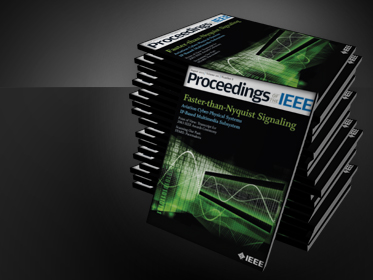 On The Cover. Montage: Johan Cedervall. |
Background
FTN methods pack 30% to 100% more data in the same bandwidth at the same energy per bit and error rate, compared to existing methods. This is its commercial attraction, but FTN also offers new ways to think about bandwidth, detection of bits and channel capacity. In particular, FTN addresses two great laws of data transmission, Nyquist’s limit to the speed of pulse transmission and Shannon’s capacity for the Gaussian data channel. The first FTN research was published by James Mazo of Bell Telephone Laboratories in the 1970s, after which the idea lay dormant for many years. It has awakened in recent years because of our networks need to carry more data and because we have the silicon technology to implement more complex signal processing.
Mazo’s work was controversial because it seemed at first glance to say that one could send data faster than Nyquist’s limit. More modern research has also led to controversy because it sometimes seems to say that one can exceed Shannon’s capacity. There is no need to worry: Both laws are still valid. The paradoxes disappear when ideas are more carefully defined. Nyquist’s limit applies to pulses that are orthogonal, which in simple language means that the pulses do not interfere with each other and can be detected separately. FTN lets the pulses interfere. The receiver becomes more complex but more data can be carried at the same error rate and in the same spectrum. Shannon’s capacity, as it is usually written, applies to signals with no spectral side lobes, that is, no energy outside a set, narrow bandwidth. Real signals have side lobes; this side lobe energy can carry a surprising number of bits, and the capacity that includes them is considerably higher.
A Few More Details
Most data transmission uses linear modulation in which a sequence of data pulses is add to form the final signal. In linear modulation, the pulses are almost always orthogonal , or “Nyquist”. Easy detection is possible with a matched filter and sampler. Currently, the most popular coding methods are based on orthogonal pulses. But there is a strong incentive in modern communication technology to make greater bit rates available to the customer, a need that can be satisfied in a number of ways. Four basic approaches are multiple-antenna techniques, improved networking, shorter radio wavelengths, and better signal design. Focusing on the last, we can ask, is there a way to carry more information per Hertz and second? This measure of efficiency is called data bit density. Transmission methods whose bit density is under 2 bits/Hz-s are called wideband (space communication is an example); those above 2 are called high energy because they achieve the same end by increasing symbol energy per channel (these are used in short range wireless communication). Most coding technology envisions wideband transmission. Increasing the bit density by increasing the symbol alphabet to octal or more is a common strategy; a consequence of this simple approach is a strong increase in the symbol energy. The FTN method can be viewed as a more sophisticated and efficient alternative.
As wireless systems offer higher and higher rates in the same radio spectrum, they need to work at a higher bit density. This requires more signal energy per bit. At the same time, whether by design or by necessity, networks are also becoming shorter range, which makes this energy available. Even space systems like satellite digital television face these demands, and fortunately have the bit energy available. FTN offers a method attuned to high energy systems, which can be coded or uncoded. It is thus an important solution to future wireless system demands.
The paper was in August among the top 100 most downloaded papers from IEEE Xplore, which is a data base providing access to more than 3-million full-text documents from some of the world's most highly cited publications in electrical engineering, computer science and electronics. The top 100 list can be found at: http://ieeexplore.ieee.org/xpl/browsePopular.jsp
Text: John B. Anderson and Viktor Öwall
2013-06-20 EIT article has won best paper award
Published: 2013-06-20
The article Measurements Based Channel Characterization for Vehicle-to-Vehicle Communications at Merging Lanes on Highway by T. Abbas, L. Bernado, A. Thiel, C. F. Mecklenbräuker, and F. Tufvesson, from EIT, has won the best paper award at 5th International Symposium on Wireless Vehicular Communications: WIVEC2013, Dresden, Germany, 2013-06-2. The authors will be invited to publish an extended version of their paper in the IEEE Vehicular Technology Magazine.
2013-06-11 Crafoord Grants to EIT
Published: 2013-06-11
The Crafoord Foundation grants for scientific research in 2013 has been published. In total, EIT gets SEK 700 000.
- This will significantly enhance our publishing opportunities, says Daniel Sjöberg.
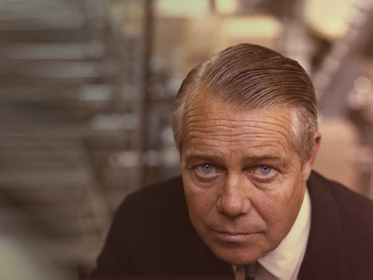 Holger Crafoord. Photo: The Crafoord Foundation. |
The money is being distributed to the following persons:
Buon Kiong Lau - SEK 300 000
Martin Stridh - SEK 200 000
Daniel Sjöberg - SEK 200 000
Research on the design of MIMO antennas
Buon Kiong Lau are going to use the awarded project grant to supplement EIT's existing research funding on the design of MIMO antennas for mobile handsets, by partially supporting a postdoctoral researcher with strong competence in the area. The focus of the project is to design efficient MIMO handset antennas, where each antenna should radiate independently of other antenna(s) in the handset.
- We really appreciate the generous support from Crafoord Foundation. Since the design is intended for frequency bands under 1 gigahertz and typical handset form factors are electrically small at these frequencies, achieving independent radiation from the multi-antennas is particularly challenging. We are proposing and actively developing a promising solution that can be implemented in real terminals without significant design changes, says Buon Kiong Lau.
"Will significantly enhance our publishing opportunities"
Daniel Sjöberg receives funding for a number of key components, including panels and probes, which extends the EIT's ability to measure antenna and scattering properties of mm-waves. It's primarily intended to allow near field measurements around 60 GHz, where several of the department's research groups are involved, among others, Mats Gustafsson, Fredrik Tufvesson, Lars-Erik Wernersson and Henrik Sjöland.
- It's very encouraging that we get this grant from the Crafoord Foundation, says Daniel Sjöberg. It gives our lab a very interesting ability to verification and characterization so far only been used on lower frequencies, and will significantly enhance our publishing opportunities.
See the complete list at http://www.crafoord.se/docs/anslag/forskningsanslag_2013.pdf
2013-06-03 Huge interest in Massive MIMO paper from EIT and ELLIIT colleagues in Linköping
Published: 2013-06-03
Our paper on Massive MIMO, co-authored by EIT researchers Fredrik Rusek, Buon Kiong Lau, Ove Edfors, Fredrik Tufvesson, Thomas Marzetta and ELLIIT colleagues at Linköping University, has gained a large interest in the scientific community. It has since it was published in IEEE Signal Processing Magazine in January been among the top 100 most downloaded papers from IEEE Xplore, which is a data base providing access to more than 3-million full-text documents from some of the world's most highly cited publications in electrical engineering, computer science and electronics.
The top 100 list can be found at:
http://ieeexplore.ieee.org/xpl/browsePopular.jsp and the paper can be found by the link below
Scaling Up MIMO: Opportunities and Challenges with Very Large Arrays
Rusek, F. ; Persson, D. ; Buon Kiong Lau ; Larsson, E.G. ; Marzetta, T.L. ; Edfors, O. ; Tufvesson, F.
Signal Processing Magazine, IEEE
Volume: 30 Issue: 1 Date : Jan. 2013
Page(s): 40 - 60
Digital Object Identifier : 10.1109/MSP.2011.2178495
2013-05-14 Solving problem from the road side
Published: 2013-05-14
On Thursday, May 16th, the Regional Finale of Venture Cup is decided. EIT is represented by Fredrik Tufvesson, in the Lifescience & Technology category. Fredrik, and two entrepreneural students from Lund School of Economics and Management, Joel Wealer and Ronny Elovsson, are behind the contribution which is based on a concept which has been developed in cooperation with two students at Faculty of Engineering, Dimitrios Vlastaras och Daniel Lestón.
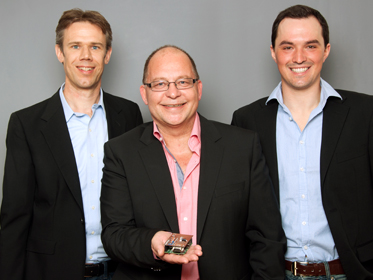 Finalists in Venture Cup. Photographer: Kiia Valavaara. |
RSVision
Joel Wealer, Ronny Elovsson & Fredrik Tufvesson
HEI: Faculty of Engineering, LTH / Lund School of Economics and Management
Mission: The industry leaders Involved in Developing the Vehicle-to-Vehicle communication network are planning to start installing the onboard devices Necessary in their newest cars starting from 2015. The problem is the early stage implementation as very few of the vehicles in circulation will actually be equipped with these onboard devices.
RS Vision addresses this problem by equipped road side units with our new technical solution.
2013-04-18 Strong numbers for EIT in LUP's download statistics
Published: 2013-04-18
Lund University Publication's (LUP) latest statistics assembly is showing pleasant numbers from an EIT perspective.
We may flourish with five of the 20 most downloaded research reports on Technology, and three of the 20 most downloaded Ph D theses (Fredrik Tufvesson, Johan Kåredal and Eligijus Kubilinskas).
In an even broader context, EIT has two within the top 14 downloaded research papers (within LU as a whole), and among the top 17 most downloaded authors, impressive eight (8!) origin from EIT (possibly nine).
I total, there's been barely 700'000 downloads of LTH generated reading from LUP since October, 2007.
For Lund Uuniversity as a whole, the figure is almost 4.8 million.
Source: "LUP i siffror"
Text: Johan Cedervall
EIT's contribution amongst the 20 most downloaded research publications (LTH):
3. Is orbital angular momentum (OAM) based radio communication an unexploited area? (Ove Edfors & Andes J Johansson) 3929
4. Bandwidth, Q factor, and resonance models of antennas (Mats Gustafsson & Sven Nordebo) 3545
14. Design of Wireless Communication Systems – Issues on Synchronization, Channel Estimation and Multi-Carrier Systems (Fredrik Tufvesson) 1851
18. A handbook formula for the inductance of a single-layer circular coil (Richard Lundin) 1562
19. A filtering technique to lower LC oscillator phase noise (Emad Hegazi, Henrik Sjöland, Asad Abidi) 1506
EIT's contribution amongst the 20 most downloaded Ph D theses (LTH):
5. Design of Wireless Communication Systems – Issues on Synchronization, Channel Estimation and Multi-Carrier Systems (Fredrik Tufvesson) 1851
11. Measurement-Based Modeling of Wireless Propagation Channels – MIMO and UWB (Johan Kåredal) 1358
19. Design of Multi-layer Telecommunication Networks: Fairness, Resilience, and Load Balancing (Eligijus Kubilinskas) 945
EIT's contribution amongst the 20 most downloaded research publications (LU):
9. Is orbital angular momentum (OAM) based radio communication an unexploited area? (Ove Edfors & Andes J Johansson) 3929
14. Bandwidth, Q factor, and resonance models of antennas (Mats Gustafsson & Sven Nordebo) 3545
The 20 most downloaded researchers:
| 1. | Bengt Johansson | 19329 |
| 2. | Anders Kjellberg | 17780 |
| 3. | Mats Gustafsson | 15611 |
| 4. | Fredrik Tufvesson | 14575 |
| 5. | Henrik Sjöland | 13741 |
| 6. | Per Tunestål | 12410 |
| 7. | Gerhard Kristensson | 11978 |
| 8. | Buon Kiong Lau | 11676 |
| 9. | Andreas Molisch | 11460 |
| 10. | Sven Bjerstedt | 11148 |
| 11. | Thomas Brante | 10840 |
| 12. | Carita Paradis | 10743 |
| 13. | Maria Kihl | 10434 |
| 14. | Anders Karlsson* | 9216 |
| 15. | Anders Persson | 8286 |
| 16. | Gunilla Jönsson | 8229 |
| 17. | Johan Kåredal | 8165 |
| 18. | Jesper Arfvidsson | 8078 |
| 19. | Kerstin Gustafsson | 8034 |
| 20. | Stephen Burke | 7539 |
EuCAP Best Paper Award
Published: 2013-04-17
EuCAP Best Paper Award
Mats Gustafsson received the best Antenna Theory Paper Award at the European Conference on Antennas and Propagation (EuCAP), Gothenburg, Sweden, April 8-12, 2013 for the paper “Convex Optimization for Analysis of Small Antennas”.
2013-04-09 EIT is Searching for Electronics Lecturer
Published: 2013-04-09
For more info, see the online job vacancy site.
2013-03-25 Three papers in the Journal of Solid-State Circuits
Published: 2013-03-25
Lund-based researchers have no less then 3 papers in the July 2013 issue of the Journal of Solid-State Circuits (which covers the conference ESSCIRC 2012 with a number of solicited papers).
The three JSSC papers are:
1) Lars Sundström, Staffan Ek, Jim Svensson, Martin Anderson, Roland Strandberg, Fenghao Mu, Imad ud Din, Thomas Olsson, Leif Wilhelmsson, and Daniel Eckerbert (Ericsson Research), "Complex IF Harmonic Rejection Mixer for Non-Contiguous Dual Carrier Reception in 65 nm CMOS".
2) Deepak Desalukunte, Fredrik Rusek, and Viktor Öwall, "A 0.8mm^2 9.6mW Implementation of a Multicarrier Faster-Than-Nyquist Signaling Iterative Decoder in 65nm CMOS".
3) Luca Fanori and Pietro Andreani, "Highly Efficient Class-C CMOS VCOs, Including a Comparison with Class-B VCOs".
EIT söker forskningskoordinator
Published: 2013-03-21
Institutionen för Elektro- och Informationsteknik har världsledande forskning inom ett stort antal områden såsom trådlös kommunikation, elektronikkonstruktion och acceleratorteknologi gentemot ESS och MAXlab. Vid institutionen drivs ett stort antal större forskningsprojekt som täcker hela spannet från grundforskning till industrinära samarbeten på både den nationella som den internationella arenan. För att ytterligare stärka forskningen inom institutionens områden ser vi ett behov av bättre koordinering av våra aktiviteter. Därför söker vi en forskningskoordinator vars roll blir att stimulera samarbete internt såväl som externt samt att göra forskningsresultat mer synliga.
Mer information på http://www.lu.se/lediga-tjanster-0/?Dnr=526402&Type=S
Pietro Andreani received award at ISSCC
Published: 2013-02-27
As the only Scandinavian 2013, Pietro Andreani received an Author Recognition Award, having (at least) ten published articles at the IEEE ISSCC (International Solid-State Circuits Conference) over the past ten years.
– - I didn't know that there was such a thing! I was informed by my friends who'd seen me on a list in the Compendium you got at the conference. I was surprised but very happy, says Pietro.
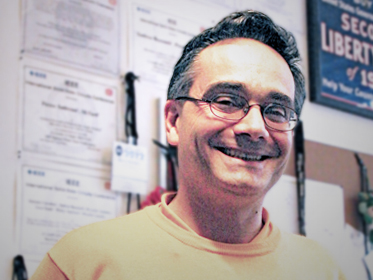 Multiple published. Pietro Andreani has published many articles at ISSCC. | |
|
Main conference
The conference's considered the most important one in the area of integrated circuits with the industry's heaviest names - including Intel, AMD, IBM, Oracle, Broadcom, NXP, Texas, Agilent with many others - on place to publish their findings and to strengthen their positions. Practically all universities in the world are represented among the 3500-4000 participants among which many are on hand to present their findings. Other for recruiting.
– A PhD student who publish anything there is almost always immediately approached with job offers. For, say, 15 years ago it was as craziest, people even tried to recruit each other! Pietro says and smiles.
The only Scandinavian
Pietro is the only Scandinavian who managed to get ten or more articles published at ISSCC in the last ten years, and thus received the ISSCC's Author Recognition Award.
–- Yes! In any case, formally it is so. I do not know if they made a mistake or not - there's a guy named Kari Halonen, who is really strong, he and his group were probably the best in Scandinavia for so-so ten years ago and published a lot, we were probably in second place after him. But - I'd say that we have gone about them and are the best in Scandinavia right now, says Pietro but for the sake of letting ostentatious. On the contrary, in fact.
Purposeful publication
He is very humble about the award, as he is very happy and proud of it. It's the fruit of years of hard and dedicated work.
– In fact, I've had a goal to really push myself to publish things at ISSCC, if I had something good to publish. One of the big problems for researchers is that, even if you have good stuff, and it gets posted somewhere - perhaps nobody reads it and it will be stillborn. I have made an effort to publish at this particular conference, it is huge and people read what you publish.
– And that's the key from academia and from industry who reads it, he adds.
Came as a surprise
The purposiveness wasn't the award he received, but the releases as such. In fact, he did not know there was an award to get.
– No, I didn't know that there was such a thing! I was informed by my friends who'd seen me on a list in the Compendium you got at the conference. I was surprised but very happy, says Pietro.
Has made a name for himself
Two years ago, Pietro Andreani held an widely appreciated tutorial at ISSCC, an extensive tutorial that was directed to large masses. He has also participated in the forum sessions, this year entitled Frequency Generation and Clock Distribution, mostly geared toward the audience want to find out what state-of-the-art in the field is located.
– Sure, I've made myself a name in the area of oscillators says Pietro while I let my gaze wander along one office wall that is virtually wallpapered with ISSCC publication diplomas...
Text & foto: Johan Cedervall
TV4 News: Refinement of innovations
Published: 2013-02-11
Lars-Erik Wernersson has participated in a long feature on TV4 News where he talks about his research. (Cut from TV4 published 7/2).
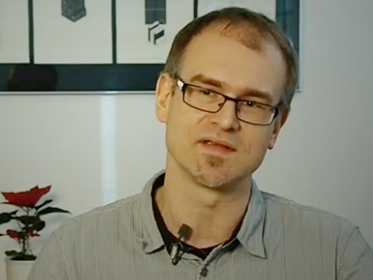 Lars-Erik. |
Scaling down
The feature begins at the Hörby Antenna claimed to be Europe's tallest building when it was completed 1959. After that, Lars-Erik Wernersson takes us on a journey to far less construction in the hunt or quest for the ultimate transistor.
– Above all, we see that we can reduce energy consumption by this and that's one of our major driving forces, to reduce energy consumption in our transistors. We all know that the laptop gets quite hot, we know that the mobile phone needs to be recharged periodically. The camera also takes out the battery. Can we reduce energy consumption, I believe we can contribute a lot, Lars-Erik says.
The borderland is special
– What's special about our research is that we are able to combine radio or mobile technology with nanotechnology - we come out of nanotechnology, we have the background in this and we use it when we produce our transistors, and then we apply this in a row of problems in communications and radar technology. And it's precisely this boundary that's special about our research, says Lars-Erik at the end of the feature and also notes the following, retrospectively:
– New technologies are born from advanced basic research, but they need to get refined and combined with other technologies to find their place in the ecosystem. This will generate new research in the border lands between disciplines. In this, EIT and LTH have good opportunities to contribute to the future development!
Text: Johan Cedervall
Bild: TV4 News
Leif Sörnmo elected IAMBE-Fellow
Published: 2013-01-28
EIT professor of biomedical signal processing has been inducted into the prestigious academy IAMBE (The International Academy of Medical and Biological Engineering).
– The appointment came as a surprise - a pleasant surprise! You don't get elected fellow by highlighting yourself, but there are others who do. It's an honor, a recognition which I obviously appreciate, Leif says.
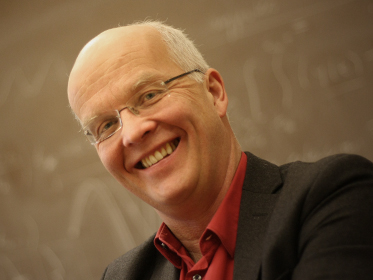 Prominent in medical technology. Leif Sörnmo's inducted into IAMBE. | |
|
Emphasizes cooperation
The International Academy of Medical and Biological Engineering (IAMBE) is made up of fellows who are recognized for their outstanding contributions to the profession of medical and biological engineering. IAMBE is part of the World Congress of IFMBE, International Federation for Medical and Biological Engineering.
– Yes, I have been elected to the Academy which is both encouraging and flattering. But I really want to emphasize the cooperation I get to have with many very talented people in the world, currently from a dozen countries. It is not only necessary for survival in terms of research, but above all it is very stimulating, says Leif.
"Recognition"
IAMBE membership requires that one or two of the following criteria are met: Important contributions to the theory or practice of medical and biological engineering. Demonstration of unusual accomplishment in promoting the field of medical and biological engineering.
– Well, I've published occasional articles on methods to better understand atrial fibrillation, says Leif and smiles:
– Otherwise, people usually a little jokingly say that when you become a fellow, it means you are approaching retirement, Leif continues with a broad smile, and turns seious:
– The appointment came as a surprise - a pleasant surprise! You don't get elected fellow by highlighting yourself, but there are others who do. It's an honor, a recognition which I obviously appreciate, Leif says.
Leif's newfound academy membership floods on his research group as well as on EIT at large.
– We have a number of fellows on EIT and of course, someone named fellow says something about the standard of research that that person's in charge of. It's a sign that significant research's conducted at the department.
Leading in Medicine and Technology
Leif's one of the initiators and moderators of engineering program Medicine and Engineering (BME) at Lund University, starting in 2009, a program that is unique in its kind and has become a success - before the second year, the total number of applicants was about 800 - on 40 spots. It's very much in tune with one of IAMBE's main objectives, which is to encourage young people to choose medical technology and to support them in their development in the area.
– I don't know if those who chose me as a fellow is aware of the program, but I must agree that it fits in quite well. It is both exciting and instructive to know and work with new people with different specializations, which you get when you work with an interdisciplinary engineering program.
Health surveillance on your mobile
Leif sees new potential future projects around the corner.
– In Region Skåne, there's a specific focus on "mobile health", which's to gather information about your health yourself, which can help you stay healthy in a higher extent. There's a lot to do in that area - and it is also unclear how it's going to get done. EIT research can provide tools with which you yourself could periodically measure heart condition, maybe several times a day. Using a smartphone, you can send the information to a center where a doctor looks at the cases that need special attention.
– There are apps today that can measure heart rate and analyze sleep depth. But they aren't very good, mainly because of the relatively poor signal processing, says Leif Sörnmo - EIT professor of medical signal processing. And now also IAMBE-fellow.
Text & foto: Johan Cedervall
Gyllene jubileumsfest (UPPDATERAD)
Published: 2013-01-16
För 50 år sedan, hösten 1962, kom de första elektroteknikteknologerna till LTH. Skolans andra civilingenjörsprogram startade – teknisk fysik var det första 1961. För att fira detta träffades lördagen den 27 oktober ett 80-tal av totalt cirka 185 teknologie doktorer, som disputerat vid EIT eller någon av dess föregångare.
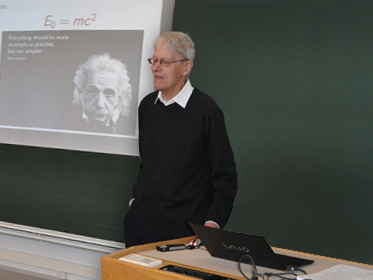 LTH:s förste doktor. Olov Einarsson redde ut begreppen kring E=mc2. | |
|
Vid E-sektionen initierades sex teknologie doktorsutbildningar svarande mot de sex institutionerna elautomatik, elektrisk mätteknik, teletrafiksystem, teletransmissionsteori, teoretisk elektroteknik och tillämpad elektronik. 2007 hade alla utom elektrisk mätteknik successivt gått samman och bildat institutionen för elektro- och informationsteknik, förkortat EIT.
Dagen inleddes med en presentation av LTHs förste teknologie doktor (1967) Olov Einarsson (bilden) som på ett mycket uppskattat sätt och med insprängd tillbakalutad humor besvarade den något provokativa frågan ”Är världens mest kända ekvation E=mc2 korrekt?”
LTHs förste E-civilingenjör Carl-Erik Sundberg (1966) berättade att han i sin ungdom byggde en radiostyrd båt. Därmed var hans yrkesval bestämt. Så småningom hamnade Carl-Erik på legendariska Bell Labs. Där satte han upp målet: 100 tidskriftsartiklar, 100 konferensbidrag, 100 patent och 100 länder. F n har Carl-Erik besökt drygt 150 länder och med god marginal passerat även övriga delmål.
Sven Mattisson är berömd kretskonstruktör på Ericsson. Han avslöjade att en syokonsulent föreslog att han borde bli bonde. Han valde i stället elektronikbanan och kunde ge oss en intressant inblick i tankarna kring tillkomsten av Bluetooth.
Presentationerna avslutades av Skotte Mårtensson – LTH-legendar redan under sin livstid. Han illustrerade E-sektionens och delvis LTHs tillkomst och utveckling med hjälp av en uppsjö foton. Nostalgin flödade som den borde en sådan dag!
Fiestan avslutades med middag i E-husets foajé–var annars? Middagstal hölls av EITs teknologie doktor Rector Magnificus Per Eriksson – även han blev nostalgisk. Dagen, som uppskattades mycket, hade planerats av Rolf Johannesson (E66) och Viktor Öwall (E82) med ovärderlig hjälp av Pia Bruhn.
Text: Rolf Johannesson
Bilder från jubileet
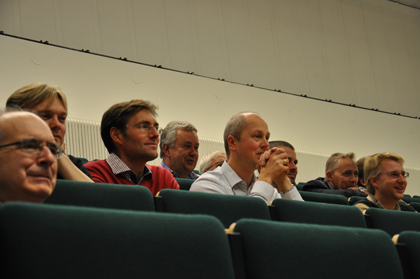
Åhörare
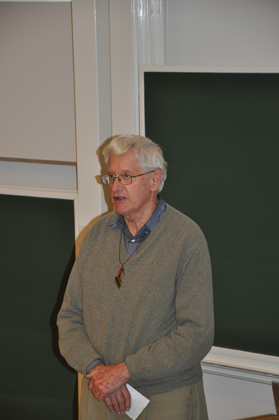
Göran Einarsson
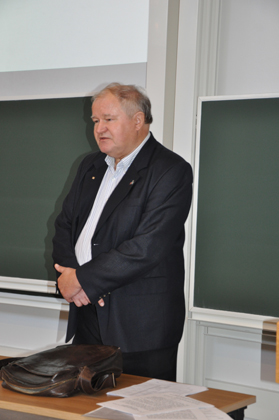
CE Sundberg
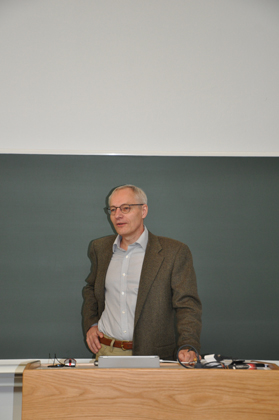
Sven Mattisson
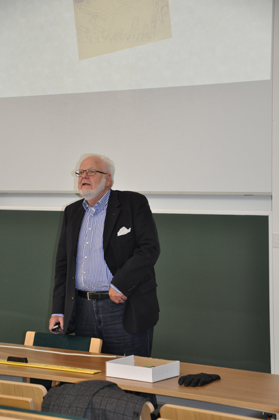
Skotte Mårtensson
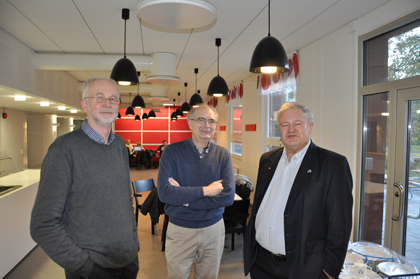
Kafferast
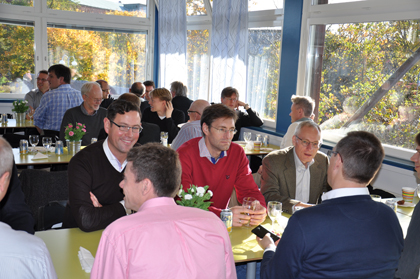
Lunch
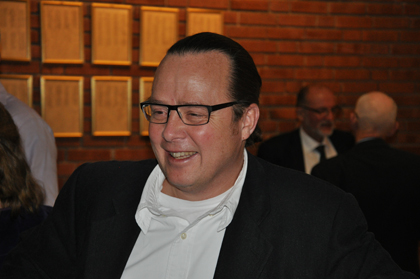
Viktor Öwall
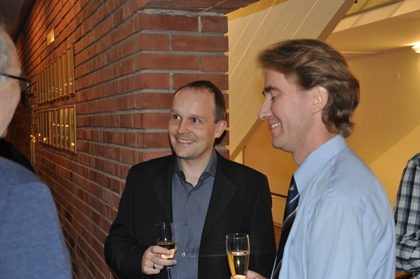
Fördrink
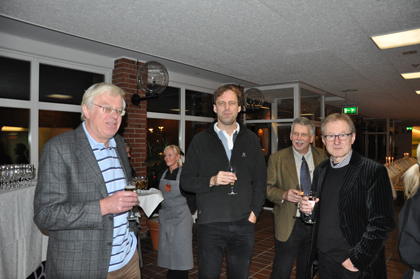
Fördrink
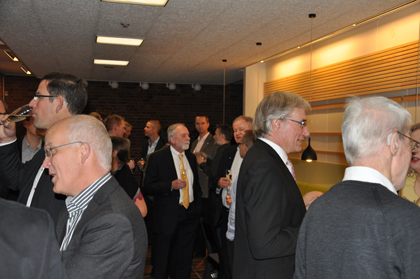
Fördrink
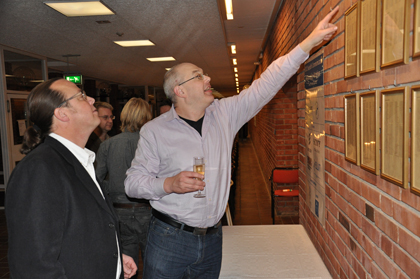
Fördrink
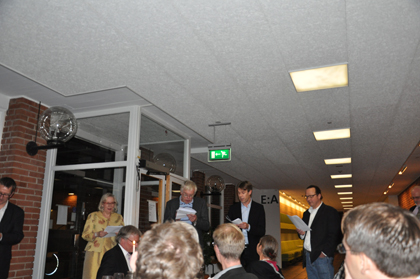
Fickspex
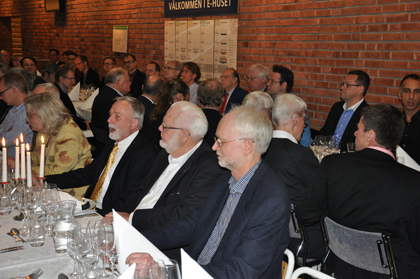
Middag
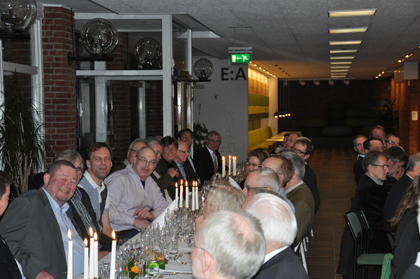
Middag
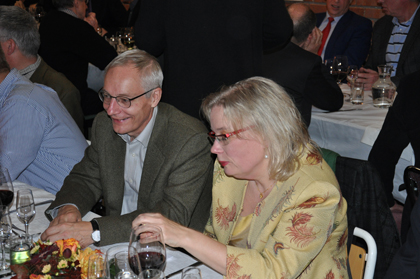
Middag
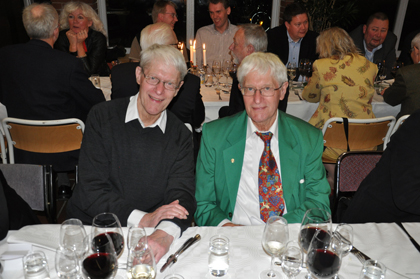
Tvillingarna Einarsson
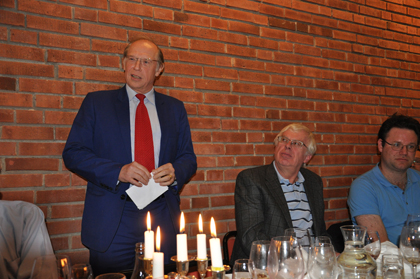
Rector Magnificus Per Eriksson
Scolarship competition settled
Published: 2013-01-16
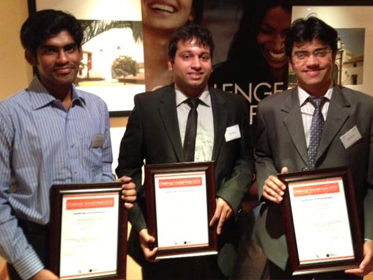 Praised. Rudra Pratap Singh won the competition, Hariharasudhan Vigneswaran placed second and Koustubh Sharma third. |
The Lund University Faculty of Engineering (LTH) has conducted a contest among Indian students, where first prize was a scholarship with full tuition fee paid for a master's degree in wireless communications at EIT - including accommodation for 2 years!
Rudra Pratap Singh from Indian Institute of Technology (IIT) became the winner of the contest, Challenge Yourself India 2013
Deepak Dasalukunte who received was a Ph.D. student at EIT between 2007 and2012 presented the award at a ceremony in Bangalore on January 11.








